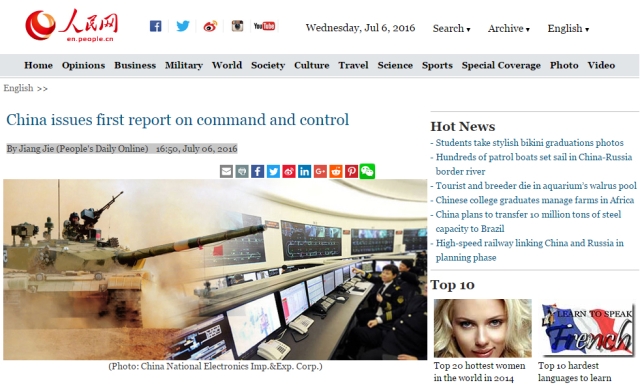中新网北京2016年7月6日电 (记者张素)中国首部《2014—2015指挥与控制学科发展报告》6日在北京发布。
报告面向国家战略需求和学科发展前沿,总结了近年来的研究成果,并就此领域提出发展建议。指挥与控制学科兴起于20世纪70年代,是综合运用自动化、信息化、智能化等高新技术,通过情报收集、信息处理、分析决策、指令编制和传递、指令执行与全程监控等过程,对群体性社会活动进行快速协调、调度、指挥、控制的学科。这部报告由中国指挥与控制学会负责编写,已于2016年4月由中国科学技术出版社正式出版。
在6日举行的发布会暨第二届智能指挥与控制论坛上,报告编写组副组长、南京大学教授周献中介绍了报告的主要内容。报告指,指挥与控制学科的一个特征就是“军民共用”,即不仅适用于作战指挥,还适用于一切非战斗军事行动,或者是有组织、有目的的群体性活动,例如抢险救灾、应急处置、消防指挥、交通管理、航空管制、生产调度、公共事务管理等。眼下,中国南方洪涝灾害备受关注。参与编写报告的专家在回答记者提问时说,应急救援指挥与控制通常由风险评估与预防、监督监控预警、应急处置与救援和综合保障四部分构成。报告称,“预防为主”是减轻灾害最重要的措施及基本原则,监测监控预警是突发事件防治的重要环节,如果在突发事件发生前作出科学的预测并及时发出预警信息,可以减少人员伤亡和财产损失。报告指出,由中国气象局牵头承建的国家突发公共事件预警信息发布系统已于2012年建成并投入运行。中国若干单一风险源监测、单一事件和灾害测试预警技术接近国际先进水平,但总体与领先国家水平还有一定差距。特别是在多灾种综合及跨领域预测预警技术刚刚起步。报告建议,应尽快推动建立扎根基层、一体化国家应急救援指挥与控制系统,建立国家级应急救援指挥与控制研究实验基地、加速相关关键技术研发,还应加快制定相关标准并加强国际合作。
同日召开的第二届智能指挥与控制论坛上,围绕“智能无人机作战前沿技术”这一主题,空军工程大学教授黄长强所作《从“阿法狗”到“阿法鹰”,浅谈无人作战飞机智能自主作战技术》的学术报告引起不少观众的兴趣。来自国防科技大学的刘忠教授和邱晓刚教授也做了学术报告。本场活动由中国科学技术协会指导、中国指挥与控制学会主办。中国工程院院士、中国指挥与控制学会理事长戴浩主持。
另外,人民网海外版也会报告的发布做了介绍,全文如下:

China issues first report on command and control
By Jiang Jie (People's Daily Online) 16:50, July 06, 2016
Chinese researchers of command and control are most interested in simulation and model studies in the military and transportation fields, whereas they place less emphasis on cyberspace, the nation’s first report on command and control detailed.
Citing data from China National Knowledge Infrastructure, the report, which was issued on Wednesday by the Chinese Institute of Command and Control, said that simulation and model studies are the most common research topics for essays published between 2010 and 2015. Cyberspace fell out of the top 10 topics completely, while most model studies revolved around military-related fields.
Professor Zhou Xianzhong from Nanjing University said during the Wednesday press conference that the most popular topics for postgraduate and doctorate degree-seekers are information fusion, genetic algorithms and drones.
Zhou, also the deputy head of the panel for the report, said command and control (C2) was first recognized as a national academic subject in 2009.
“C2 examines the integration of military and civilian affairs. There are many cutting-edge technologies involved in C2, but they come from the military and are therefore classified,” Zhou said. Zhou pointed out that China has a large group of C2 research fellows, many of who come from military academies and research institutes with military backgrounds.
“However, compared to other countries, we see a lack of innovation in theory studies, and many theories have not yet been put into practice on actual programs,” he said, adding that, although cooperation between institutes and academies has been fruitful so far, that collaboration must be further strengthened.
Moreover, Yao Fuqiang, a research fellow with the Nanjing Telecommunication Technology Research Institute, told People’s Daily Online that there is still a gap between China and the countries that lead in privacy security technology when it comes to the electromagnetic spectrum.
“It is necessary to guarantee security and control of the electromagnetic spectrum, which necessitates dealing with three threats: band occupation, spectrum interruption and information interception and leakage,” Yao told People’s Daily Online. However, Yao added, China is gradually seeking leadership and initiatives in the International Telecommunication Union, which often falls under the West’s domain.
Chen Tao, an associate research fellow with the Department of Engineering Physics at Tsinghua University, said at the conference that C2 systems in emergency rescue have been serving the public at the state-level through the China Meteorological Administration. There are plans to complete a provincial-level early warning system by 2020.
“The next step will be to expand the early warning system to media outlets that can more easily reach the public,” Chen said.
(For the latest China news, Please follow People's Daily on Twitter and Facebook)(Editor:Jiang Jie,Bianji)
(责编/李浩)


